Every cloud has a silver lining….When life give you lemons, make lemonade. Well, a few positives to come out of the pandemic for me included on-line wine events, tastings and education.
I capitalized on an online education opportunity offered by Symington’s School of Port and completed “The Essentials” course online. It’s a self-paced 16-episode video series targeted at wine trade professionals that offers the opportunity to learn about port and the Douro.
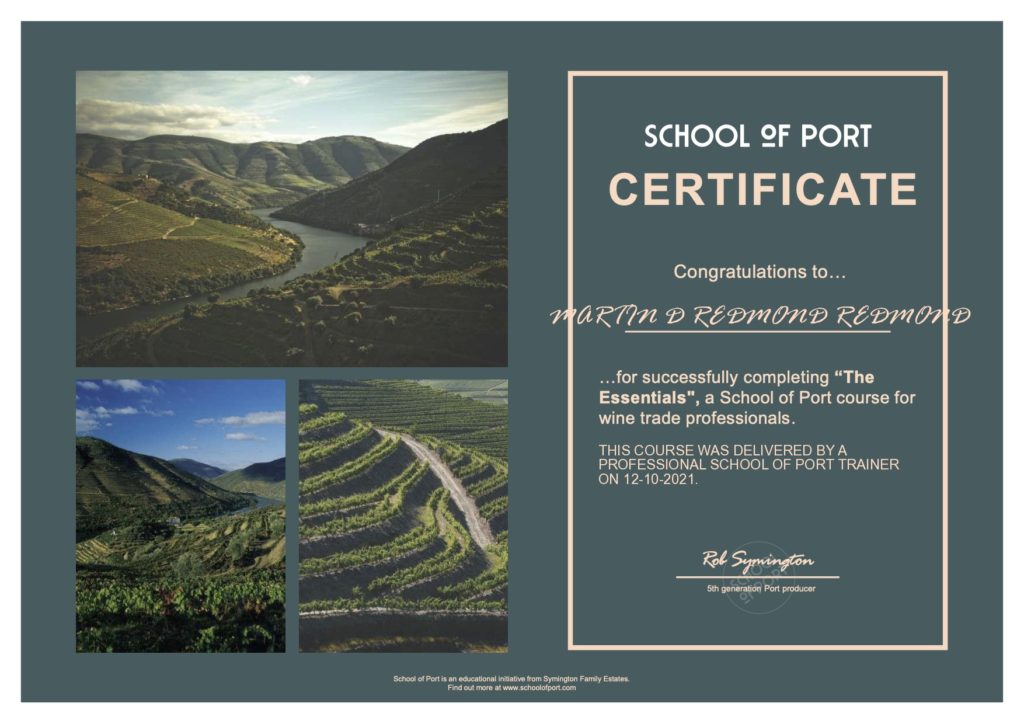
Hosted by Symington’s port educator Isabel Monteiro, the 2 hour course provides foundational knowledge of port including its history, terroir, sustainability initiatives, production, port styles, aging processes, serving port, cocktails, etc. It includes a short test afterward.
I passed that test and earned the certificate seen above.
As good fortune would have it, I had several media samples of various styles of port, including white port, reserve ruby, and tawny.
As always, for me, the best way to learn is by tasting, so I thought it would be fun to taste through the samples while at the same time provide a primer on port.
I purchased a bottle of vintage port to round out this primer because I wanted to canvas the predominate and most readily styles of port available in the market.
Disclosure: These wines were provided as media samples are noted as such in my tasting notes. No other compensation was involved. All opinions are mine.

Port At A Glance
- Port is a fortified dessert wine from the Douro Valley in Portugal. The first shipments of wine under the name Port were recorded in 1678.
- In 1756 the Marquis of Pombal created a government controlled agency to regulate port production – making Port is the oldest demarcated and regulated wine region in the world
- The Douro Valley is a UNESCO World Heritage site recognized for its stunningly beautiful terraced, vine-covered topography shaped by more than 2,000 years of winemaking.
- The region has singular climate and soil characteristics for the production of predominately indigenous grape varieties that contributes to the distinctive characteristics of the wines and guarantee that Port wines are irreproducible elsewhere.
- The principal grape varieties are Touriga Nacional, Touriga Franca, Tinta Roriz (a.k.a. Tempranillo), Tinto Cão, and Tinta Barroca.
- The delimited Port region is approximately 250,000 hectares. It is divided into three distinct sub-regions (see map below) Baixo Corgo, Cima Corgo and Douro Superior.
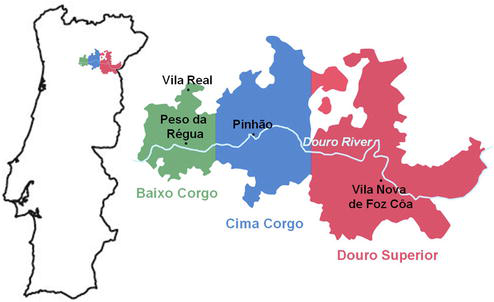
How Port is Made
The base for Port is made like any other wine. Grapes are grown, mostly hand-harvested, pressed and fermented with yeast, which converts the wine’s natural sugars into alcohol. In the production of fortified wine, however, there’s an additional step. Before all the sugar has been converted to alcohol, a neutral grape spirit is introduced to the wine. This process is known as fortification explains Wine Enthusiast.
Once the wine has been fortified with the neutral grape spirit, it kills the remaining yeast and stops fermentation. The resulting wine retains some of its residual sugar, resulting in off-dry to sweet final profiles, and possesses a higher alcohol content, typically around 20% alcohol by volume (abv).
After the vinification process, young ports, are reviewed to determine which have better aging potential and whether they are better-suited for aging in wood or in bottle. Thereafter are they are usually stored and aged in wood barrels of different sizes (wines intended for Ruby and Vintage Port wine production will be aged in large wood barrels and that intended for Tawnies will be aged in small ones) from 2 years to many decades in accordance with the intended style.
It’s important to note that port comes in various styles, whose colors range from white to deep purple, with diverse aroma and flavor profiles and shades of sweetness.
Styles of Port
As seen in the chart below, port can be split into two distinct categories: wood aged or bottle aged. The only true bottle aged port is a vintage port, while the other ports are all wood aged to some extent.
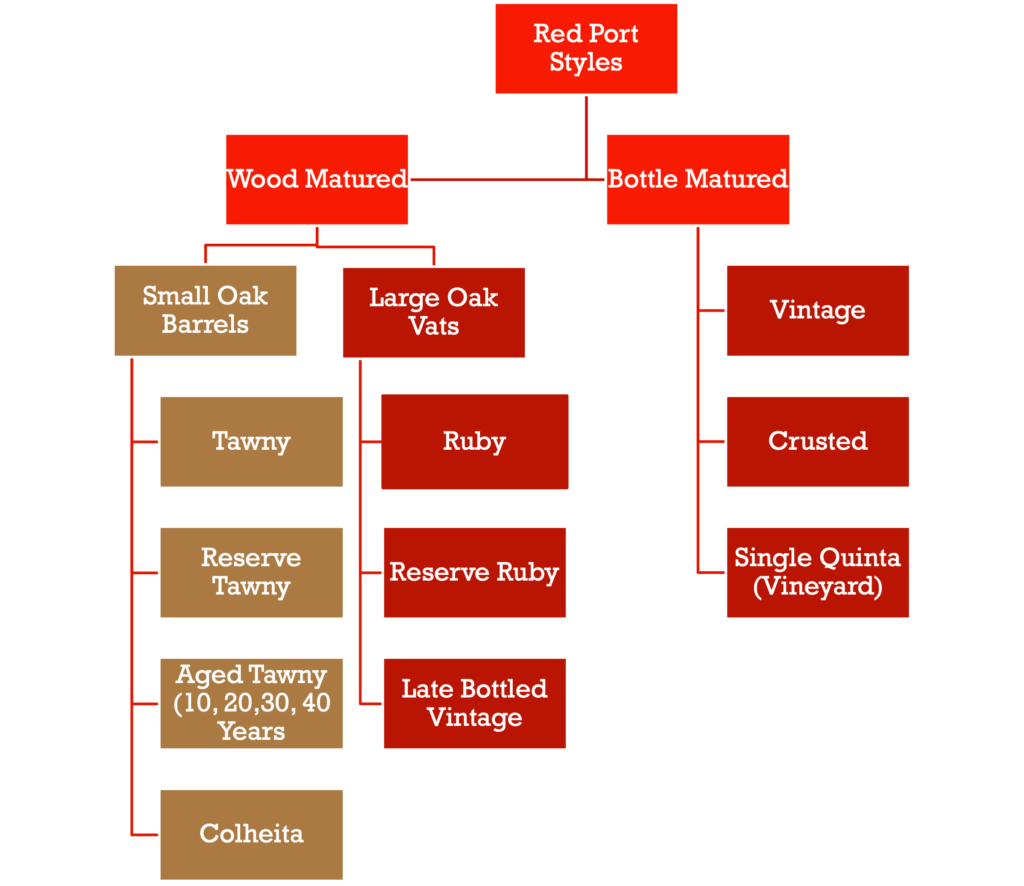
Within the two categories of port, there are four main styles of Port wine – Ruby, Tawny, White and Rosé.
How To Serve and Store Port
- Port should be stored in a cool environment, away from strong light (the same as with a still wine).
- Vintage Port should be stored lying on its side, with the liquid in contact with the cork, at a stable temperature below 15° C (60° F).
- Tawny Ports are best enjoyed slightly chilled (between 10 -14° C / 50° – 57° F).
- Ruby / LBV / Vintage Port are best enjoyed slightly around room temperature (14 – 18° C / 57° – 65° F).
- After opening all port benefits from fridge storage. Depending on storage condition they can retain their quality for up to 2 months. The exception is Vintage port which is best consumed 3 to 4 days after opening (as are traditional LBVs and Crusted Ports).
- Serve port in a white wine glass. The standard pour of port is about 3 ounces (remember port is around 20% abv!)
Port By The Glass
White And Rosé Port
White port is made in small quantities by about 30 using the same blend of native white grapes (Rabigato, Viosinho, Malvasia and Gouveio) used to make Douro’s dry white wines. However, the style accounts for only 10% of all port production. White Port wines usually age for two or three years in large wood barrels. Its classifications include Standard, Reserve, Aged (10, 20, 30, 40 years) and Colheita
Rosé or Pink port is a new style of port wine, that was first introduced by Croft in 2008. It is technically a Ruby Port but fermented in a similar way to a Rosé wine, with limited grape skin maceration, thus producing the pink pink wine with flavors of strawberry, violets and caramel. It, like the most white port, is an easy drinking wine served chilled, over ice or even is a cocktail.
Cockburns Porto Branco
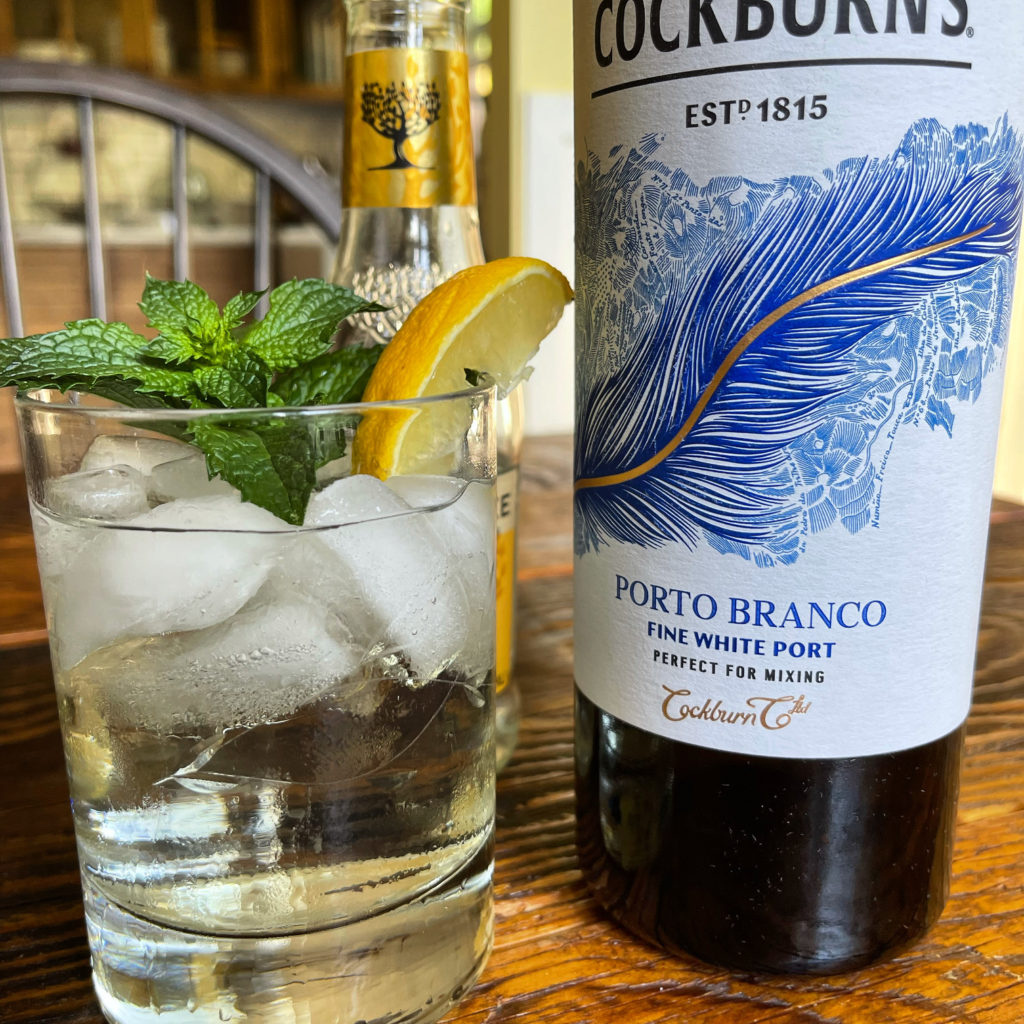
We used to this wine to make Porto Tonico (White Port and Tonic), a very refreshing drink that is wonderful on a hot day!
Tasting Note:
On its own this one is very pale gold color with an appealing yellow apple, subtle caramel, vanilla, and almond character with a hint of lemon blossom florality. 19% abv|SRP – $14.50|Sample
Ruby Port
Ruby ports are aged in large oak vats with little contact with wood and less oxidation. They are rich, and full-bodied with a red and black fruit character, with polished tannins and fresh acidity. They are made for immediate consumption. Reserve ruby ports, which are considered premium version of Ruby ports are aged up to 2 years longer. Late Bottled Vintage port( (“LBV”) is a ruby port from a single year, chosen for its high quality and bottled after aging for four to six years in wood. It is a vintage Port in style, but not in price.
Cockburn Porto Special Reserve
Originally introduced in 1969, Cockburn’s Special Reserve bridged the gap between vintage ports and their younger counterparts, creating the approachable yet more complex Ruby Reserve port category.
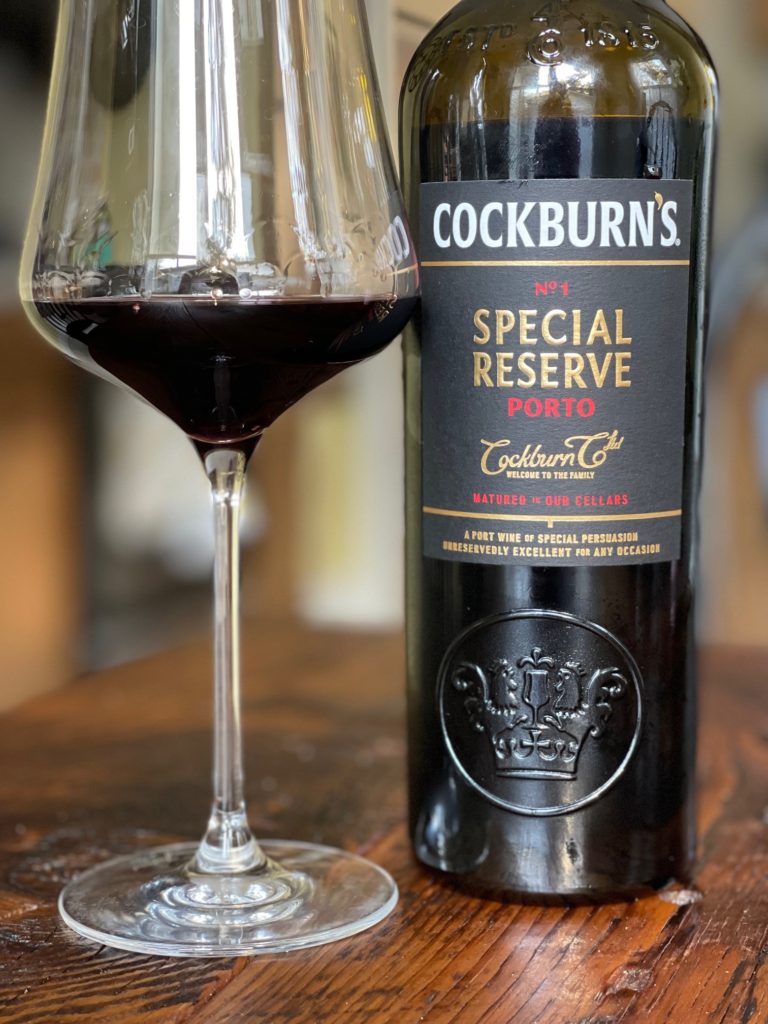
Tasting Note:
Opaque dark ruby color with black and black raspberry liqueur, ripe raspberry, plum vanilla, bittersweet chocolate, cedar and cinnamon stick aromas. On the palate, it’s full-bodied with medium-acidity and supple tannins. It shows rich, black cherry and black raspberry liqueur, strawberry compote, plum, bittersweet chocolate and vanilla flavors. 19.5% abv|SRP – $20|Sample.
For more information about Cockburn’s click here
Graham Porto Six Grapes Reserve
This wine is a blend of equal amounts of Tinta Roriz, Touriga Nacional, and Touriga Franca from two or three years vintages, with an an average of five to six years old when it is lightly filtered and bottled.

Tasting Note:
Opaque dark ruby color with ripe black cherry cobbler, plum sauce, cedar, vanilla and dark chocolate aromas. On the palate, it’s between medium and full-bodied and moderately fresh with velvety, sweet tannins. It shows luscious black fruit cobbler (black cherry, blackberry), ripe plum, vanilla and dark chocolate flavors with a hint of baking spice with a warm very satisfying finish. 19.5% abv|SRP – $27 |Sample.
For more information about Graham’s Port, click here.
2016 Dow Porto Late Bottled Vintage
Dow sources fruit for this wine from the same Douro Valley vineyards, Quinta do Bomfim and Quinta da Senhora de Ribeira it uses to produces its vintage port. The wine is in matured in Dow’s historic Boavista Lodge in Vila Nova de Gaia.

Tasting Note:
Dark ruby color with very appealing aromas of violet, subtle lavender, black fruit, leather, pine needles and a hint of leather. On the palate it’s medium-bodied and fresh with chalky tannins and mixed blackberry and blueberry compote, fresh ripe fig, and mocha flavors. 20% abv|SRP $26|Sample.
For more information about Dow’s Port, click here
Tawny Port
Tawny port is aged in seasoned small oak barrels, and is thereby transformed through contact with the wood and micro-oxidation. Tawny port is elegant and refined with considerable length on the palate and generous acidity. Generally speaking they show dried fruit, toasted nut, spices, orange peel, honey, and roasted coffee character.
“10 Years” indicates an average age – this Aged Tawny Port is a blend of older wines, which offer complexity and younger wines, which bring fresh fruit flavors and vibrancy.

Tasting Note:
Deep tawny color with a garnet rim and toffee, dried fig, marzipan, candied orange peel, cinnamon, and vanilla aromas. On the palate it’s full bodied with supple, mouth-filling sweet flavors of toffee, dried fig, cinnamon, honey and vanilla. 20% abv|SRP -$37|Sample
N.V. Dow Porto 20 Year Old Tawny
“20 Years” indicates an average age – this Aged Tawny Port is a blend of older wines. It’s more complex, and structured character than the 10 Year Tawny. It’s more supple on the palate with a more nutty and dried fruit character.

Tasting Note:
Mahogany color with amber an amber rim, and toasted walnut, butterscotch, spice cake, dried fig, and mocha aromas. On the palate it’s full-bodied and unctuous with silky tannins and Morello cherry liqueur, honey, butterscotch, orange marmalade, vanilla flavors with a long surprisingly dry and subtly minerally finish. 20% abv|SRP-$67
Vintage Port
Vintage port is at the pinnacle of the Port quality pyramid. It requires a combination of painstakingly choosing the best parcels, for the finest locations, picked at optimal ripeness from an outstanding growing season to produce a vintage port. It is a wine made from a single, exceptional year that spends no longer than two years in barrel before being bottled.
2018 Taylor (Fladgate) Porto Vintage
A blend from Quinta de Vargellas in the Douro Superior (‘the backbone’) and Quintas Terra Feita and Junco in the Pinhão Valley.
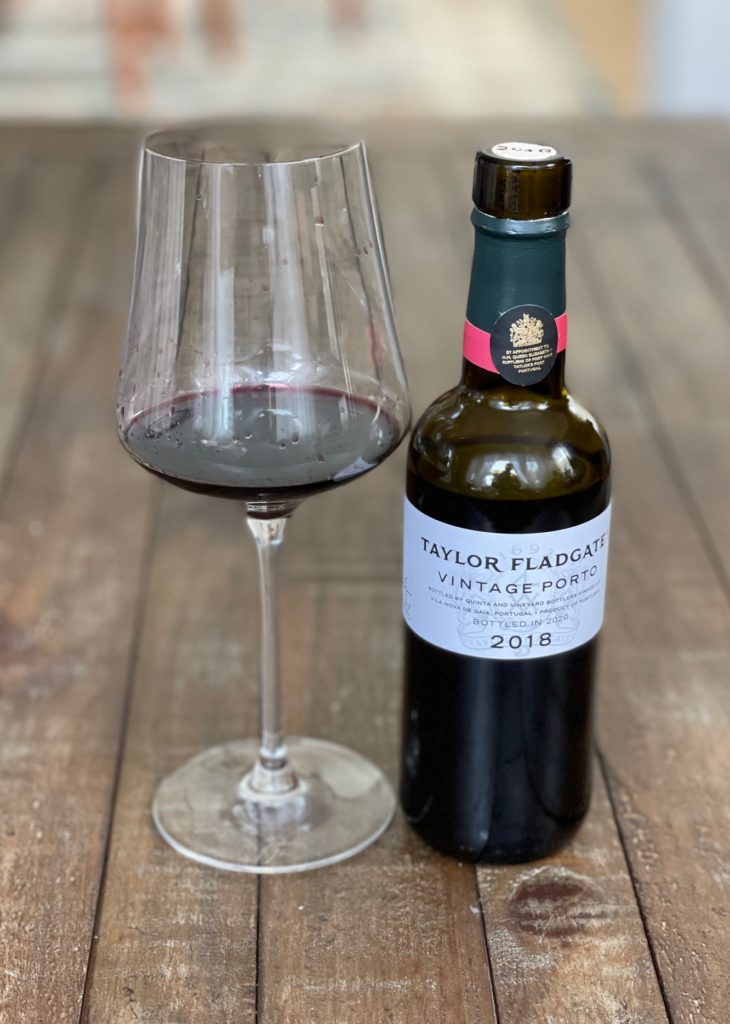
Tasting Note:
Violet-black core with a narrow purple rim and aromatic blackberry, fig, baked black cherry cobbler, dried herb, and violets aromas with subtle minty notes. On the palate, it’s full-bodied, dense, and focused with bright acidity and velvety tannins with an other-worldly texture. It shows blackberry compote, black cherry cobbler, ripe fig, vanilla, mocha, mint, dried herb and spice flavors with a long finish. This wine has the perfect balance of
sweetness, acidity and tannins for me. 375ml| 20% abv| SRP – $54.99.
For more information about Taylor-Fladgate, which celebrates its 330 anniversary this year, click here.
My Takeaways
The Taylor-Fladgate vintage port was hands down my favorite. It’s drinking well now, but will improve with age….if you have the patience to wait another 10-20 years. It will age more quickly in the half-bottle size.
The 2016 Dow’s Late Bottled Vintage (“LBV”) port offers terrific quality for the price For my money, I’d spend the extra $5-$10 on the LBV over the Reserve Ruby port depending on the price differential (though,I did think both were very good).
I’ve had limited experience with Tawny port, and they were both 10-year, which I thought were very good. I thought the Dow’s 20-year Tawny was outstanding.
As for the difference between Ruby and Tawny port? It would depend on the “mood and the food” for me. One of my favorite easy dessert pairing is a small serving of a Ruby Reserve port with a bit of dark chocolate. And truth be told, 95% of the time I’ve either enjoyed port on its own or with chocolate.
Pairing port with Blue Cheese is a classic, but I’m not a big fan of Blue Cheese, so I rarely have some on hand.
Inspired my “research” for this post, and wanting to pair port with something other than chocolate, I paired the Dow’s 20 year Tawny with Banana Walnut Bread Pudding topped with Bourbon Caramel. Whoa! Fantastic pairing!
Many thanks to Calhoun & Company Communications for the samples!
________________________________________________________________________
Follow me on Twitter, Facebook, and Instagram and for all things wine. As a wino with latent foodie tendencies, you’ll also find plenty of food and wine pairings, and wine related travel stuff! Become a fan and join ENOFYLZ Wine Blog on Facebook. Cheers!
Copyright Notice: This entire site is Copyrighted 2010-2022. All Rights Reserved. No unauthorized copying of any section of this site is permitted. If you wish to use any part of this site, contact me. For information on Copyright Law, see the official U.S. Copyright Office home page.
Sounds like a fantastic course! Like you we find the best way to learn is to taste…our trip in November to Portugal was such a great education. I lean toward the tawny port…particularly the 20 year Tawnys as they’re such good comparative value. That being said, we really didn’t meet any ports we didn’t enjoy 😉
I thought it was a very good course! I hadn’t thought about looking at the styles of port through the lens of wood-matured v. bottle-matured, but I found that to be helpful. There were some good food pairing tips beyond the typical recommendations as well. Easy to watch and informative!